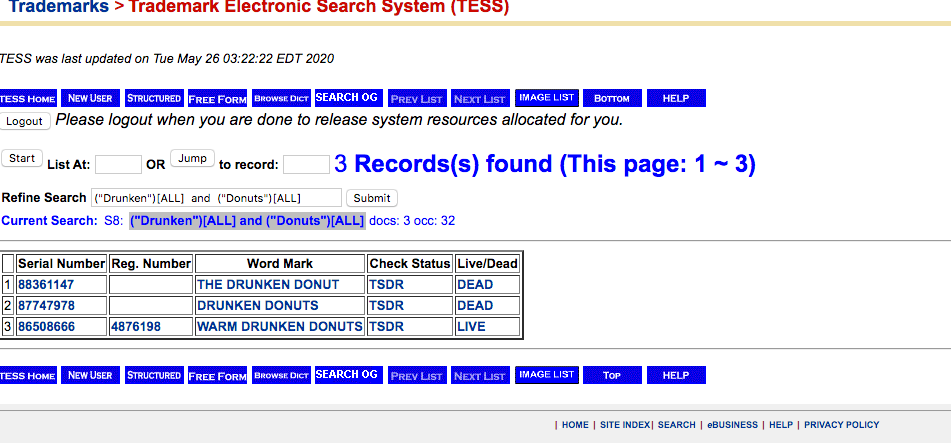How to Search Trademarks (Part 2)
If you’ve read the first article in this series on basic trademark searching and feel ready to expand your skills, read on! This article covers how to search trademarks and more advanced searching techniques within the USPTO’s Trademark Electronic Search System (TESS).
USPTO fields
TESS gives you the option to search all fields within its databases, and understanding what information is contained in these fields will help you identify search criteria. When you first open a record, you’ll see its visual mark. For a standard word mark, it will be a word in block lettering. If it is a design mark, you’ll see a drawing of the logo, then fields such as these:
- Word Mark: the word portion of a mark, such as “AmazonFresh.”
- Goods and Services: a list of all goods and services tied to the mark, in order by International Class (IC).
- Serial Number: This number assigned to the record.
- Filing Date: The date the application was filed.
- Description of the Mark: Words that are within the written description of the mark.
- Current Filing Basis and Original Filing Basis: How the application was filed under current trademark law.
- Owner: Name and address of the owner of the mark.
- Type of Mark: Trademark, Service Mark, Collective Mark, or Certification Mark.
- Register: Principal or Supplemental
- Disclaimer: Some words are descriptive, and the USPTO may require a submission to disclaim use of them except as part of the mark. For example, “Jane’s Bakery” would likely require a disclaimer of the word Bakery apart from the use of the mark as shown.
Other fields are also present. You can identify field definitions by clicking the “Help” button in TESS and selecting “Search Fields.”
Search Options
TESS gives you the option to do a Word and/or Design Search in either Structured or Free Form. Using the Structured search is a good way to get used to the system and the way queries are built. Once you’e familiar with the system, you can use the Free Form to develop advanced queries.
Using the Word Mark “Drunken Donuts” as a test search, here are some examples that test out different search options. The following shows a search on “Drunken Donuts” using the AND connector and searching ALL fields.
This search returned the following records:
If we change the connector to OR, we get many more records, including those which contain either Drunken or Donuts in ANY field, not just the name of the product.
The number of records needs to be narrowed down, and there are various options to limit results, including selecting only certain fields. For example, select the field “Description of Mark” instead of using “ALL.” Searching for classes of marks can also help limit search results and identify potential items that may present a conflict with what you are seeking to trademark.
Once you’re more familiar with the fields and search criteria, you can also use the “Free Form” search and enter in the field codes manually. When you select the “Free Form” search option, you will be taken to a page which allows you to develop your own queries. The US Trademark Field Codes are also found on this page for your use. The syntax might look something like this: Drunken[BI] and DONUTS[BI]. This search is querying the “Basic Index” for Drunken and Donuts.
Wildcards were discussed in the basic trademark search article, and you can incorporate them in your advanced searches as well. The $ and * apply, as well as a question mark (?). This can be used to match a single non-blank character. For example, if “Drunkena Donuts” were in the system, searching with the ? would likely find this result. However, “Drunkenna Donuts” would not be returned because there are two non-blank characters present.
Design Code Search
If you’re seeking to search marks that include designs, you’ll first need to identify the design codes. The USPTO assigns a six-digit numerical classification to elements of a design as a means of categorizing them. The first two numbers represent category, the second indicates division, and the third pair of numbers equals the section. An example used by the USPTO is the five-pointed star, which is represented by 01.01.03. The first “01” represents the category of celestial bodies, natural phenomena and geographical maps, the second “01” represents the division of stars, comets and the third set of numbers, “03,” represents the section containing stars with five points. To obtain a design search code, you will need to search the Design Code Search Manual first. The link for this database is provided on the initial Search Options page. Once you have the codes, you can select the field Design Search Code[DC], if you are using the Free Form option, and search on the desired design elements.
Other Trouble Spots
Other things to be aware of when searching TESS include punctuation, substitutions, foreign words, and variations on a name. All of these can change search results. For example, 4 and “for” will yield different results, so both should be searched. “EZ” and “easy” is another example – search both variations to be sure you’re getting more thorough results.
In summary, the USPTO advises using these principles to conduct existing trademark searches:
- Conduct a Thorough Search.
- Search All Forms of all the Distinctive Elements of the Mark.
- Search Each Distinctive Element Alone.
- Search Acronyms AND What They Stand For.
- Search All the Legal Word Equivalents of Terms.
- Search Component Parts of Individual Terms When Necessary.
- Searches for Marks Consisting of Two or More Separate Terms
Should be Conducted so that the Two Terms Would be Retrieved Whether They Run Together or are Separate. - Search Pictorial Equivalents for Distinctive Terms and Vice Versa
When Appropriate. - Search all Phonetic Equivalents
- Search all English Equivalents
Further Reading on How to Search Trademarks
For more information on how to search trademarks, check out Chapter 4 of our free interactive ebook, The Intangible Advantage, and Sections 8 and 9 of our free online course Intellectual Property: Inventors, Entrepreneurs, Creators.
Disclaimer: Nothing in this article shall be construed as legal advice, or as creating an attorney/client relationship.
___
 The Michelson Institute for Intellectual Property, an initiative of the Michelson 20MM Foundation, addresses critical gaps in intellectual property education to empower the next generation of inventors. Michelson 20MM was founded thanks to the generous support of renowned spinal surgeon Dr. Gary K. Michelson and Alya Michelson. To learn more, visit 20mm.org.
The Michelson Institute for Intellectual Property, an initiative of the Michelson 20MM Foundation, addresses critical gaps in intellectual property education to empower the next generation of inventors. Michelson 20MM was founded thanks to the generous support of renowned spinal surgeon Dr. Gary K. Michelson and Alya Michelson. To learn more, visit 20mm.org.




A Step-by-Step Guide to Trademark Searching in the U.S., Part II: The Basics of Using Google’s trademark search engine is here, and part III on data mining—an essential reference for anyone who wants more precise estimates about how much money people have spent filing trademarks.